How To Make A Formal Garden At A Moderate Cost. Continued
Description
This section is from the book "How To Make A Flower Garden", by Wilhelm Miller. Also available from Amazon: The Well-Tended Perennial Garden: Planting and Pruning Techniques.
How To Make A Formal Garden At A Moderate Cost. Continued
Above all, avoid the curious and the grotesque unless you are ready frankly to accept the idea that the garden is to be a museum - a place for the display of freaks. When you do this, do not inflict it upon all your friends all the time. A very retired nook behind a very high hedge would be an appropriate place for Alexander Pope's "Imagery in Evergreen Subjects," with which a "virtuoso gardener" would "ornament villas and gardens" to distinguish them from the "barbarous countries of gross nature." Fancy "Adam and Eve in yew, Adam a little shattered by the fall of the Tree of Knowledge in the great storm, Eve and the Serpent very flourishing";

"St. George in box, his arm scarce long enough, but will be in condition to stick the dragon by next April; a green dragon of the same, with a tail of ground ivy for the present; an old Maid of Honour in wormwood."
Neither should there be attempted in the flower gardens of small home grounds a pattern in walks and beds so complicated that it cannot be traced by the eye, unless all flowers are omitted from the beds. The very crooked walks and beds of such designs are difficult to care for.
In determining the location, the relative size of beds, walks, and other features, it is the harmony of good proportion and fitness which gives artistic merit to a good design. Good proportion comes largely from intuition; fitness grows out of knowledge and good sense.
In making the design for beds, bear in mind that it is difficult to cultivate from one walk a bed more than four feet wide, or one more than eight feet wide between two walks. If beds are to be wider, narrow walks through the center will be needed. It is hardly necessary to say that beds should be most thoroughly prepared, if the most luxuriant growth, best health and greatest abundance of flowers are to be secured; and as this garden represents a comparatively small part of the lot, such preparation can usually be afforded. Use two feet of good and well-enriched garden soil, with tile drains a foot deeper under each bed, leading to a free outlet, especially in heavy soils. If necessary, accept for the time being the soil as it is with a very thorough spading, with the addition of a very large amount of well-decomposed manure, and then approach the ideal treatment as rapidly as possible.
The width of a walk is governed largely by usage. If a horse and cart are to be used, a walk should be from six to eight feet wide; a wheelbarrow will require a walk three feet wide; if two persons are to walk abreast comfortably, the walk should be four or five feet wide; narrow walks in the center of beds should be from one and one-half to two feet wide. Walks made of a permanent material require less care and are more comfortable to use at all times. A first-rate material is good red brick, laid on a six- to ten-inch foundation of loose gravel, cinders, or sand, with a low crown to shed water. Other coloured brick will in some cases be as good or better. Slate flagging upon the same foundation is good. Cement concrete is neat and clean, and durable if well laid, but the colour is not as good as brick. Tar concrete and asphalt blocks are an abomination in colour. Thin sheets of sandstone, limestone, or other flat-surfaced rocks of irregular outline, make serviceable and picturesque stepping-stone walks when joints are made close enough to prevent the heel of a lady's shoe from being caught in them, and with edges next to beds made straight. Such a walk should also have a porous foundation.
If, however, the cost of such a foundation cannot be undertaken, lay the stones directly upon the soil. If the action of frost makes the surface of stones too uneven, they can be replaced easily. A macadam walk of crushed stone four inches deep, or a similar surface of binding gravel, makes a firm walk, but dirt will track from it to the house, and weeds will grow in it. A surface of smooth, round pebbles is clean and free from weeds, and often gives an excellent colour-effect when carefully selected, but it does not pack well. A turf walk is often used, but it holds the wetness of dew and rain, and it does not sharply outline the pattern of a formal garden, because there is not colour contrast enough between it and the planted beds. If you do not care to go to the cost of such surfacings, use the soil of the garden as a walk. It will be muddy and dusty at times, but occasional mud and dust need not seriously detract from your pleasure.
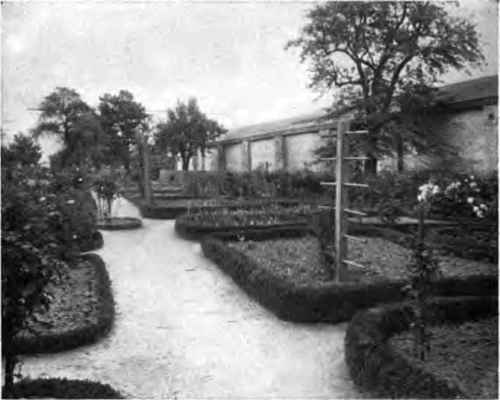
Formal beds edged with box.
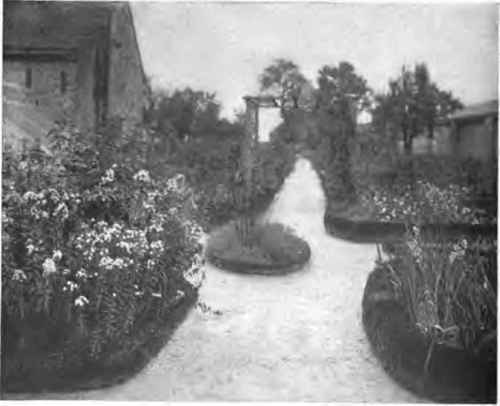
A modest formal garden in Germantown, Pa.
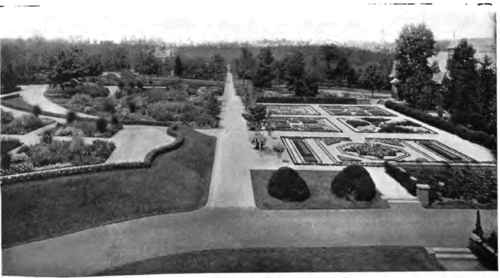
Two distinct styles of formal gardening side by side.

Stately steps descend into the formal garden.
A low, true edge of some material should be formed next to the bed to hold walks and earth in place; and, in addition to this, a verdant edge of such plants as dwarf box, ivy, or the dwarf high-bush cranberry - all of which can be held by trimming to a rigid line. Less desirable as an edging are such plants as the narrow-leaved blue day-lily and the dwarf irises. A turf edge is much less expensive, but it lies too flat to make a distinct line of demarkation.
Water in basins and fountains adds much to the attractiveness of a formal garden if it can be secured to give a constant flow to fountains or falls. A fountain that is put on tap for company is likely to be a snare and a delusion. If your garden is a show-place, maintained chiefly for the benefit of occasional visitors, such a fountain on tap may be all right; but if it is a place to live in, you want the water daily, just as you want the flowers daily. Even if you do not use water as a feature in the garden design, it is very desirable, and in some places quite essential, that you have it from hose connections for watering beds. Where the water-supply is limited, it can be used to make a wet spot for bog plants, or it can be used in a shallow basin as a water mirror, in which fishes, but not plants, can be kept, but in which plants grown along the side will be reflected; or as a small stream running from a spouting head into a basin in a wall, from which it will drip to a lower basin with an outlet. If there be a column of water, it should be continuous and strong. • In the construction of basins-, cement is most serviceable and least expensive.
Of course, in winter the water should be shut off; but if, in the construction of the basins, the sides are made flaring instead of perpendicular, the action of ice is not so likely to burst them.
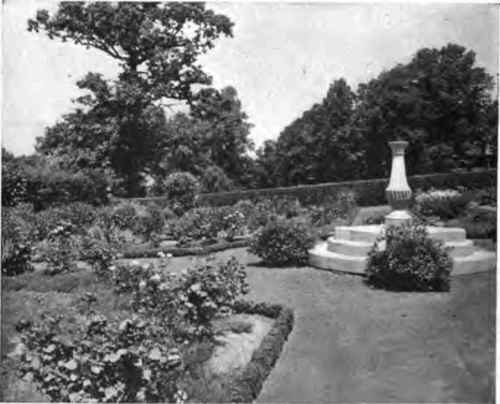
Where the sun-dial has the place of honour.
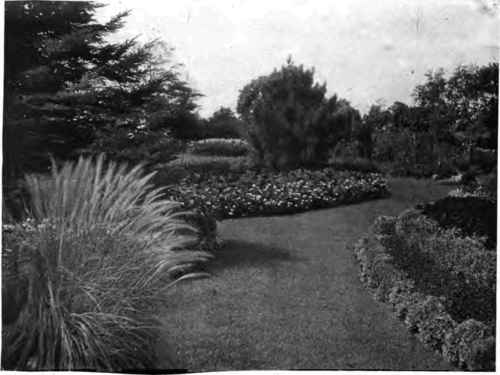
A common example of bedding-out. At a niece of bedding itself, this represents a very successful example. It is very questionable, however, whether, as an artistic composition, such bedding is in place on the margin of an informal lawn.
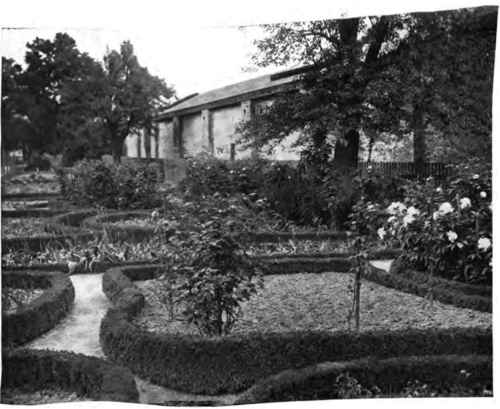
Bits of old box hedge, as prlm and square-cut as a puritan pastor.
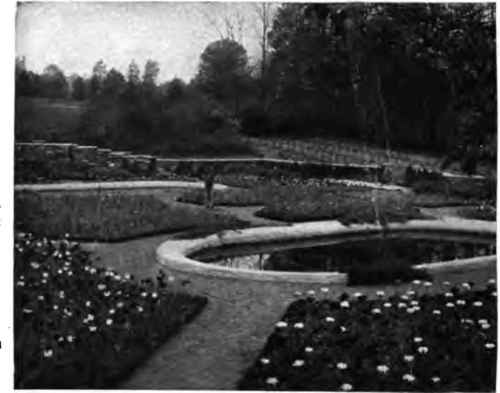
Bulb time in the formal garden.
A hedge as a boundary for a garden is appropriate; but, owing to the amount of space it will ultimately occupy, its interference with the growth of garden plants, the trouble of keeping it in good condition, and its lack of flowers, it is usually best to substitute substantial brick or stone walls, if the house be of brick or stone, or wooden fences if the house be of wood. The objection to wood lies in the difficulty of repairing and painting it when covered with vines.
An appropriate place for seats, arbours, sun-dials, and other useful and attractive accessories will be found as the plan develops.
In planting, the purpose should be to establish an effective display of colour in foliage, flowers, twigs, or fruits in their season, rather than a varied and interesting collection of plants - if it is a flower garden rather than a botanic garden that is to be created. This will be accomplished best by using in large quantities the few varieties that will give the best floral or other effects desired, rather than many varieties in small quantities. Obviously, trees or shrubs having a wide spread cannot be used unless trimmed constantly.
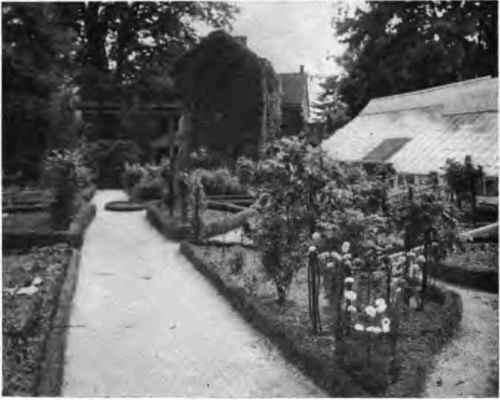
Standard roses and pyrethrums near the greenhouse.
Continue to:


